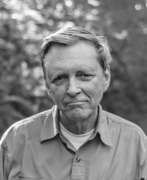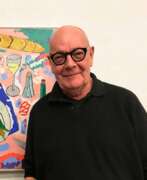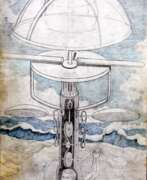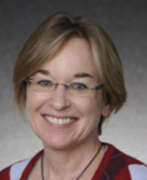Mountain landscape Contemporary art


Robert Adams is an acclaimed American photographer known for his profound exploration of the American West's changing landscapes. His work, which gained prominence in the mid-1970s, delves into the tension between the natural beauty of the land and the marks of human encroachment. Adams's photography is a reflection on humanity's relationship with the environment, offering both a critique and a celebration of the landscape.
Robert Adams's notable series, such as "Turning Back" and "The New West," showcase his unique perspective on environmental and urban development issues. His work extends beyond just capturing images; it is a thoughtful commentary on the balance between nature and industrialization. His photographs, often devoid of people, focus on the land itself, telling a story of alteration and resilience.
Exhibitions of Adams's work, such as "American Silence: The Photographs of Robert Adams" at the National Gallery of Art, provide insight into his 50-year career and his ability to capture the silent yet profound narratives of the American landscape. His pieces are part of major collections and have been featured in numerous retrospectives, underlining his influence and significance in the world of photography.
For art collectors and enthusiasts, Robert Adams's work offers a poignant perspective on the American West, blending aesthetic beauty with critical environmental commentary. Engaging with his work invites reflection on our interaction with the landscape and our role in shaping the environment.
If you're interested in staying updated on Robert Adams's work and exhibitions, consider subscribing to newsletters from galleries and museums that feature his art. This way, you'll be informed about new displays of his work and opportunities to engage with his insightful perspectives on the American West.


Saad Al-Tai is a contemporary Iraqi artist. He participated in several exhibitions in Baghdad and abroad. Al-Tai was a member of the Iraqi Impressionists Group. Despite the name of the group, Al-Tai was not categorically an impressionist, rather his style lent more towards cubist realism. For him, the colour of the painting was determined by its subject matter. Al-Tai is an award winning artist who, amongst other things, received Italian knighthood in 2005 in recognition for his efforts in fostering Iraqi-Italian cultural dialogue including founding and heading the Italian Language Department in 2002 at the College of Languages, Baghdad University.


Virginia Berresford is an American artist and printmaker.
Virginia Berresford studied with George Bridgman at the Art Students' League and in Paris with Amedee Ozenfan from 1925 to 1930. Berresford was known for her landscape paintings with strong composition and use of colour as well as attention to detail.
In the 1950s she opened an art gallery in Edgartown, Martha's Vineyard. Her work is included in the permanent collections of the Whitney Museum of American Art, the Detroit Art Institute and the Dallas Museum of Art.


Herbert Brandl is one of the most famous Austrian expressionist artists. He achieved success through his large-format works.
Landscape as a theme was always dominant in his work, where pictorial abstraction and subjectivity alternate. Since the beginning of the new millennium, Brandl's passion for the monumentality of mountain landscapes has become increasingly evident. Using various formats and techniques, the artist has reinterpreted the theme of mountains, playing with expressive gestures, abstract colour spaces and massive forms.


Georg Dinz is a contemporary Austrian artist. After studying at the Vienna University of Applied Arts, Dienz lives and works as a room and stage designer in the Viennese punk scene. Shortly after the fall of the Wall, Dienz moves to Berlin, where he takes part in various art projects in the wild post-reunification period. Today he concentrates on free painting in his studio in the former Berlin artist district of Prenzlauer Berg. Georg Dienz's works are stylistically characterized by a flat and clear application of paint and can be described as "reduced realism".


Zacharias Heinesen is a Faroese painter. He is the son of the writer and artist William Heinesen.
His works include oil paintings, watercolour paintings, drawings, woodcuts, lithographs and paper collages.
His paintings were featured on a series of stamps in June 2001.


Elmar Kopp is an Austrian painter and sculptor, received artistic training from Toni Kirchmayr in Innsbruck. Despite losing his right hand in a work accident in 1949, he studied painting under Josef Dobrowsky and Herbert Boeckl, and sculpture under Fritz Wotruba at the Academy of Fine Arts in Vienna from 1951. Kopp completed his studies in 1954 and became a freelance artist in Imst. He created landscape, floral, and figurative paintings, as well as numerous public artworks such as sculptures, frescoes, sgraffiti, and mosaics. Kopp also provided designs for stained glass windows and tapestries woven by his wife, Midi. He traveled extensively throughout Europe, Africa, and Asia. In 1982, he was awarded the title of Professor by President Rudolf Kirchschläger.


Jesús Mari Lazkano is a Spanish Basque painter. He graduated in fine arts from the University of the Basque Country, where he is Professor of Fine Arts, and has had exhibitions in Europe, America and Asia. Some of his work is part of the Bilbao Guggenheim Museum collection.
Along with Jose Venero, he made the movie Artiko, which was selected to appear at the In The Palace International Short Film Festival in Varna, Bulgaria, and the Ulju Mountain Film Festival, South Korea.


Raymundo Martinez is a Mexican landscape painter and printmaker. His subject matter is the reinterpretation of the Mexican landscape: he painted the vast expanse of land, creating an ideal environment for the rapid growth of the metropolis.
The president of the country, Adolfo López Mateos, was a patron of the artist from 1958 to 1964 and willingly presented his works to heads of state. The works of Raimundo Martínez can be found in various Mexican embassies around the world, as well as in the collections of national political figures.


Hiroyuki Masuyama is a prolific artist and photographer renowned for his innovative approach to visual art. Masuyama's journey into the world of art began with his education in Tokyo, where he graduated from the Tokyo National University of Fine Arts and Music, and continued with further studies in mural painting at the Graduate School of the same university. He later expanded his academic horizons to include studies in Düsseldorf, Germany, where he now lives and works.
Hiroyuki Masuyama is celebrated for his intricate lightbox artworks that reimagine the landscapes and seascapes by renowned artists like J.M.W. Turner, offering a contemporary perspective on these classic scenes. His work involves a meticulous process of digital photography, where he captures thousands of images to recreate historical artworks or landscapes in a new light, essentially blending time, space, and medium. His projects, such as the detailed reinterpretation of Turner's journeys and the "Rome 1585-2012" solo show, showcase his commitment to bridging historical art with modern photographic techniques.
Moreover, Hiroyuki Masuyama has engaged in ambitious projects that document landscapes in a way that challenges traditional perceptions. His exhibitions, like "Nature" at Artoll Kunstlabor and "Mountain" at Merck Finck & Co., demonstrate his fascination with nature and historical sites, encapsulating them within the modern framework of LED lightboxes.
Hiroyuki Masuyama's work has garnered international attention, leading to exhibitions across Europe and Asia. His innovative use of technology to merge photography with painting invites viewers to explore the intersections of history, art, and contemporary media.
For collectors and experts in art and antiques, Hiroyuki Masuyama offers a unique blend of historical reverence and contemporary innovation. His artworks not only pay homage to the past but also challenge viewers to consider the ways in which modern technology can alter our perception of historical and natural landscapes.
Stay updated on Hiroyuki Masuyama's latest projects, exhibitions, and available works by signing up for updates from galleries and museums that feature his art. This subscription will ensure you are informed about new product sales and auction events related to Masuyama's work, offering insights into the fusion of traditional themes with contemporary art forms.


Ramon Surinyac is a Spanish painter living and working in Barcelona, Spain.
Ramon Surinyac holds a Bachelor of Fine Arts from the University of Barcelona. From a distance, his paintings look like large photographs of snow-capped mountain vistas, ocean waves or forest jungles, but when the viewer gets closer, he discovers the artist's amazingly realistic skill.


Ernesto Tatafiore is an Italian artist, one of the forerunners of the Italian Transavantgarde that emerged in the early 1980s.
Naples, where Tatafiore's studio is located and which is a favorite place for his work, has a decisive influence on his work. Vesuvius is an obsessive image of the artist and a source of his inspiration. The theme of the French Revolution is also a recurring theme in his work.


Petra Ellen Eva Thalmeier is a German artist, draftsman and designer.
Petra studied painting at the Academy of Fine Arts in Stuttgart, and has worked as an excavation draughtsman and illustrator of archaeological finds. She participated in the creation of large posters and catalogs for the Ethnological Museum in Munich. Petra Thalmeier's greatest love is mountains, and her paintings are dedicated to them. She also works in the field of interior design creating wall murals. She has participated in numerous exhibitions.


Egon Arnold Alexis Freiherr von Vietinghoff was a German-Swiss painter, author, philosopher and creator of the Egon von Vietinghoff Foundation. He reconstructed the lost painting techniques of the Old Masters, and created some 2,700 paintings.
The immense work of Egon von Vietinghoff includes all classical motifs: flowers, still lifes, landscapes, portraits, nudes, and figural scenes. Due to the large demand, more than half of his total work consists of fruit still lifes. The beholder's normal distance to the picture procures balanced representation and self-contained calm of the object. Without losing himself in details, Vietinghoff leads the eye through the whole spectrum of nuances of color and finds the balance between intensity and gentle peace. Thus, he created the impression of unity and harmonic interaction of object and background, light and shadow, form and color, detail and totality.


James Darrell Northrup Weeks was an American artist and an early member of the Bay Area Figurative Movement. Unlike many artists in the movement, Weeks was never known for painting in a non-representational style, instead using abstraction in the "ideas of painting."


John Kyffin Williams was a Welsh landscape painter who lived at Pwllfanogl, Llanfairpwll, on the Island of Anglesey. Williams is widely regarded as the defining artist of Wales during the 20th century.


Konrad Winter is an Austrian artist known for his so-called "camouflaged" paintings.
He depicts ordinary modern life in cities: children playing, streets and parks, or it's a mountain landscape, a rural idyll. But it's all blurred, about the way myopic people without glasses see the world. It is as if the artist reveals to the viewer a magical, looking-glass world.


Franz Anatol Wyss is a Swiss painter known for his unique style and contributions to art and culture. He was born on May 1, 1940, in Fulenbach, Switzerland. His artistic journey began with training at the School of Art and Design (Kunstgewerbeschule) in Lucerne from 1960 to 1961. Later, he continued his studies at the Art School of Zurich in 1965-66 under the guidance of Bruno Stamm. Wyss's works span a variety of styles, with a focus on drawing, printmaking, and painting.
Wyss's art is characterized by its exploration of landscapes and surrealist themes. His pieces have gained recognition and are part of various auctions and collections, indicating his significant presence in the art world. Over the years, Wyss has traveled extensively, exhibiting his work in Berlin and other European cities. His studio has been in Murgenthal since 1985, and his art is exhibited in galleries and museums in Switzerland and beyond.
Collectors and art experts appreciate Wyss's distinctive approach to surrealism and his ability to blend geometric and organic elements in his work. Several of his pieces have been sold at auctions, reflecting his popularity in the art market. Some of his auctioned works include Landschaft, Surrealistische Architekturstudien, and Komposition mit geometrischen Objekten.
To stay updated on Franz Anatol Wyss and other related product sales and auction events, consider subscribing to reputable art auction websites and galleries. Signing up for these updates will keep you informed about new opportunities to acquire his artworks and learn more about his exhibitions and career.































